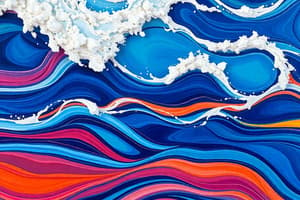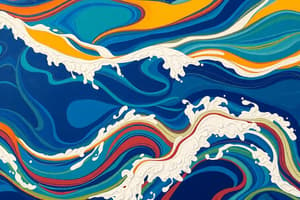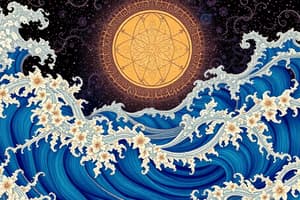Podcast
Questions and Answers
What is the primary cause of waves?
What is the primary cause of waves?
- Wind pushing on the surface of the water (correct)
- The rotation of the Earth
- The gravitational pull of the moon
- Changes in water temperature
How do waves cause erosion?
How do waves cause erosion?
- Waves create underwater currents that erode the ocean floor.
- Waves directly melt rocks and cliffs.
- Waves break up rock formations by repeatedly hitting them. (correct)
- Waves carry sand away from the shore.
What is the main factor behind the formation of ocean currents?
What is the main factor behind the formation of ocean currents?
- A combination of factors including wind, temperature, salinity, and the shape of the ocean floor and shoreline (correct)
- The rotation of the Earth
- The gravitational pull of the moon
- The shape of the ocean floor
How does the Gulf Stream affect Europe's weather?
How does the Gulf Stream affect Europe's weather?
What is the difference between spring tides and neap tides?
What is the difference between spring tides and neap tides?
What is the main effect of El Nino on weather patterns?
What is the main effect of El Nino on weather patterns?
What is the primary function of jetties along shorelines?
What is the primary function of jetties along shorelines?
Which of these is NOT a factor that influences ocean currents?
Which of these is NOT a factor that influences ocean currents?
Flashcards
Waves
Waves
Waves are the up and down movement of surface water that carry energy, not water, forward.
Wave Breaking
Wave Breaking
Waves slow down and break as the top gets ahead of the bottom when approaching shallow water.
Ocean Currents
Ocean Currents
Ocean currents are steady flows of water driven by wind, temperature, salinity, and ocean floor shape.
Gulf Stream
Gulf Stream
Signup and view all the flashcards
El Nino
El Nino
Signup and view all the flashcards
Tides
Tides
Signup and view all the flashcards
Spring Tides
Spring Tides
Signup and view all the flashcards
Jetties
Jetties
Signup and view all the flashcards
Study Notes
Waves
- Waves are the up and down movement of surface water.
- Waves carry energy, not water forward.
- Waves slow down as they approach shore where the water is shallow.
- The top of the wave gets ahead of the bottom, causing it to break.
- Waves are caused by wind pushing on the surface of the water.
- Waves erode rock and transport sand.
- Hurricane winds cause large waves that can lead to storm surges.
- Wave motion can be converted into electrical energy.
Ocean Currents
- Ocean currents are steady flows of water in a regular pattern.
- Steady winds, temperature, water salinity, and the shape of the ocean floor and shoreline drive ocean currents.
- The Gulf Stream is a warm Atlantic Ocean current that runs north along the eastern coast of North America.
- The Gulf Stream makes the weather in Europe warmer than other places at similar latitudes.
- A rip current is a flow of water moving away from the shore against incoming waves.
El Nino
- El Nino is a climate pattern in which water in the South Pacific gets unusually warm.
- El Nino disrupts normal weather patterns, causing extreme weather like droughts and floods.
Tides
- Tides are the cyclical rise and fall of ocean water levels.
- Tides are caused by the gravitational pull of the sun and moon on the Earth's oceans.
- The moon's gravity creates two bulges in Earth's oceans, leading to high tides.
- The areas between the bulges experience low tides.
- Spring tides occur when the sun, Earth, and moon are aligned, resulting in the highest high tides and lowest low tides.
- Neap tides occur when the sun, Earth, and moon are at a 90-degree angle, resulting in the smallest difference between high and low tides.
Changing Shorelines
- Shores are the land at the edge of the ocean.
- Waves and ocean currents carry sand to and from the shore.
- Wind causes rocks and cliffs to weather.
- Storms can erode beaches quickly.
- Beach restoration involves replacing and stabilizing sand, as well as building structures like jetties.
- Jetties are structures made of rock that prevent currents from moving sand, preserving beaches and keeping waterways open for boats.
Studying That Suits You
Use AI to generate personalized quizzes and flashcards to suit your learning preferences.




